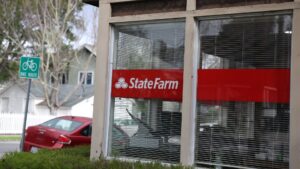State Farm’s Crucial Rate Hike Hearing: What Homeowners Need to Know
As the sun rises over California, a storm brews within the state’s insurance landscape. This week, State Farm, the largest property insurer in California, is advocating for a significant rate hike for homeowners, seeking to navigate the perilous waters of financial instability precipitated by the recent catastrophic wildfires in Los Angeles. This case, under the scrutiny of an administrative judge in Oakland, is about more than just numbers—it represents the future of coverage for nearly 3 million Californians.
The Need for a Rate Increase
State Farm has been hit hard by the Los Angeles wildfires that wreaked havoc in January, resulting in economic losses estimated between $250 billion and $275 billion—making this disaster the costliest of its kind on record. The insurer claims it requires the increase to shore up its capital and ensure its long-term viability in a state where the cost of natural disasters is mounting. With over 2.75 billion already paid out on nearly 12,390 claims, and projected direct losses reaching $7.6 billion, the company’s financial health hangs in the balance.
State Farm General’s current plea is for a 17% rise in homeowner premiums—a figure reduced from an initial 22% request. Additionally, they are seeking an even steeper 38% increase on policies covering rental dwellings and 15% for renters themselves. The stakes are high, not just for the insurer but for its policyholders who rely on coverage during inevitably turbulent times.
A Comparison to the Titanic
During this pivotal three-day hearing, the situation has been likened to the Titanic sailing toward an iceberg—time is of the essence, and course correction is imperative. An attorney from the California Department of Insurance warned, "If we don’t, 3 million Californians are going into the water, and there are not enough lifeboats."
This powerful analogy underscores the urgency of the matter and the critical role that both insurance regulators and the company must play to avert disaster—financial or otherwise.
Past Trends and Future Implications
Historically, California’s insurance market has faced volatility due to escalating claims driven by a surge in natural disasters over the past decade. Insurance Commissioner Ricardo Lara has been cautious in approving substantial rate hikes, often resulting in insurers either limiting new business or, as seen with State Farm, halting homeowner policies altogether.
Earlier this year, State Farm made headlines by stopping the issuance of new homeowner insurance policies in California—a move that shocked many in the industry. The decision to not renew 72,000 policies**, predominantly affecting homeowners, was framed by rising financial pressures and the increasing risks associated with climate change.
Furthermore, a recent report from S&P Global placed State Farm’s California subsidiary on "CreditWatch Negative" due to deteriorating underwriting performance. This troubling trend raises alarms not just for State Farm but for the sustainability of every insurer operating within the state.
The Call for a Sustainable Insurance Strategy
In direct response to the escalating crisis, California has initiated a "Sustainable Insurance Strategy." This framework aims to enhance rate-setting practices by integrating catastrophe modeling and reinsurance costs into the pricing of policies. Janet Ruiz from the Insurance Information Institute emphasizes that the timely implementation of this strategy is essential to stabilizing the state’s insurance marketplace.
While some, including economist David Appel, argue that a 17% increase could pave the way to stability for State Farm, not everyone is on board. Consumer advocacy group, Consumer Watchdog, strongly opposes the hike, asserting that the company has not provided adequate justification for any increase, much less the reigning necessity of further financial demands.
Conclusion: A Shift in the Insurance Landscape
As Extreme Investor Network follows this unfolding story, it’s crucial to be aware that the implications of State Farm’s potential rate changes extend far beyond just numbers on a balance sheet; they affect the very fabric of home insurance for millions across California. Homeowners must stay informed and prepared, as these decisions could dictate both their financial security and the landscape of insurance in an increasingly unpredictable climate.
Stay tuned to Extreme Investor Network for further updates on this developing situation, and ensure you’re equipped to navigate these turbulent waters.

